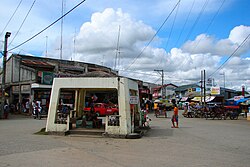Spanish Period
Historically, Ubay was part of Talibon, when the latter was established as a town in civil aspect in 1722. [1] During Spanish period, a town has two aspects - religious, headed by the parish priest and civil aspect, headed by a gobernadorcillo. The religious aspect was then considered superior to the civil aspect, as the church held significant influence over daily life and governance during that time. [12]
In 1744, the Dagohoy Revolution started, controlling the entire northeastern part of the province, stretching from Duero to Inabanga that lasted up until 1829. As the revolution progresses, Jesuit were replaced by Augustinian Recollects in Bohol in 1768 led by Fr. Pedro de Santa Barbara, who travelled through mountains with proposals of peace and resettlement for Dagohoy and its followers. Through his untiring intrepidness, later on, pacified patriots together with their cluster chieftains chose to resettle in southern coastal towns. Later in 1794, Fr. Manuel de la Consolacion, then parish priest of Inabanga, successfully brought hundreds of followers and resettled them in towns of Talibon and Inabanga, as well in the barangays (villages) of San Pedro (Talibon), Pangpang (Buenavista), and Ubay. [13] Therefore, much of early residents of Ubay were followers of Dagohoy.
In 1821, [1] Ubay became an independent town from Talibon in civil aspect, but due to the Dagohoy Revolution, the newly established town of Ubay did not operate as an independent town because most of the inhabitants resisted the Spanish Government. Up until 1846, Ubay was not listed among the towns in the island of Bohol. [14] Then, according to a Tax Census dated September 1, 1847, [15] Ubay was officially listed, which served as the basis for its reorganization and indication of a functioning town, marking September 1, 1847 [15] as the foundation date of Ubay. The first gobernadorcillo of Ubay was believed to be Toribio Reyes, whose name and the year 1872 are inscribed on one of the old church bells of Ubay Parish (Parroquia de Ubay), and who was the only son of Berudja, the legendary matriarch of Ubay.
The religious aspect of Ubay was still administered by the parish of Inabanga, until Talibon was able to establish a separate parish in 1831, [16] making Ubay a visita with its chapel made of wood. The official religious aspect of the town was established much later than the civil aspect.
On June 26, 1874, a written petition [17] was made by gobernadorcillo Saturnino Boyles along with the Community Heads, and the Household Heads of Ubay for an independent parish, separate from Talibon. To support their cause, they voluntarily constructed a decent rectory.
Then, on October 22, 1877, [16] [17] an independent parish in Ubay (Spanish Era: Parroquia de Ubay, Present: Santo Niño de Ubay Parish) was established by a diocesan decree under the patronage of the Holy Child. This was done through Royal Order No. 695 of the Ministry of Overseas dated October 5, 1876, issued by the King of Spain Alfonso XII, [10] creating an independent parish in Ubay, and a confirming decree dated November 22, 1876 from the Spanish Governor General José Malcampo, 3rd Marquess of San Rafael. Cabulao (presently San Roque, Mabini) was included as its visita. [16]
The first parish priest of Parrioquia de Ubay (presently Santo Niño de Ubay) was P. Fr. Blas Adan del Pilar, from the Order of Augustinian Recollects, who served from October 1877 until February 1884, before he was transferred to Consolacion, Cebu. [18] He succeeded by P. Fr. Benito Garayao del Carmen, from February 1884 - February 1886; P. Fr. Franscisco Vega de la Virgen de Vico from November 9, 1884 to April 1890; P. Fr. Leon Inchausti del Rosario from February 26 - March 20, 1890; P.Fr. Buenaventura Marrodan del Carmen from March 20, 1890 to 1897; and P. Fr. Juan Bea de la Virgen del Villar, from May 14, 1897 to December 20, 1898. [19]
Ubay holds its town fiesta every January, as it is the official feast month of Santo Niño, [20] a tradition that continues to this day. Ubayanons far away often come home during the fiesta to celebrate, reunite with loved ones, and honor their cultural heritage. The town comes alive with parades, music, and religious services, as the community gathers to relive traditions and strengthen their ties to home.
Modern Period
On September 1, 1947, the municipality of Ipil was reorganized, joining the barangays of Guinobatan, Mahagbu, and Tagum from Ubay together with other barangays of Talibon to create the renamed municipality of Trinidad through Executive Order No. 80. [23]
On June 21, 1956, barangay Babag separated from Ubay together with other barangays of Carmen, Sierra-Bullones, and Trinidad to form the new municipality of Dagohoy through Executive Order No. 184. [24]
On March 14, 1961, barangays of Corazon and Magsaysay separated from Ubay together with other barangays of Trinidad to form the independent municipality of San Miguel through Executive Order No. 423. [25]
On December 29, 1961, barangay San Isidro (not the present San Isidro, Ubay) separated from Ubay, together with other barangays of Candijay, Guindulman, and Sierra-Bullones to create the municipality of Pilar through Executive Order No. 460. [26]
On June 21, 1969, barangays of Aguining, Basiao, Bonbonon, Gaus, Pitogo, and Tugas separated from Ubay to create the independent municipality of Pitogo in virtue of Republic Act 5867. [27] It was later renamed President Carlos P. Garcia in honor of the 8th president of the Philippines on October 27, 1977 through Presidential Decree No. 1228. [28]













